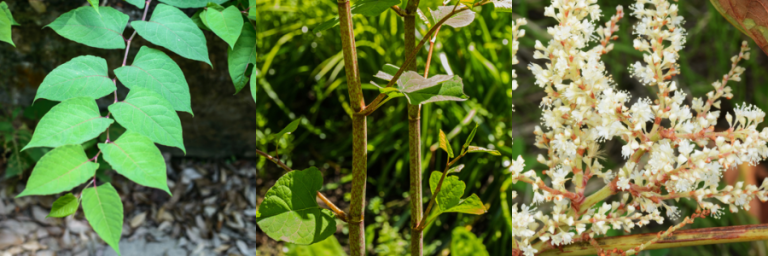|
The number of Japanese Knotweed claims are rising fast. But before considering the legal implications of the presence of Japanese Knotweed, it may be helpful to understand more about the nature and characteristics of the plant itself.
What is Japanese Knotweed?
Japanese Knotweed is an invasive, East Asian plant species. The diseases and pests that control it naturally are not present in the UK, so it spreads rapidly. In summer, it grows up to 10 centimetres a day, quickly overwhelming other plants. Currently, it’s thought to be the fastest-growing species in the UK.
How does Japanese Knotweed spread?
Japanese Knotweed seeds rarely germinate. Instead, an extensive and ever-expanding underground root system known as ‘rhizomes’ supports the plant. A single plant develops a wide spread of rhizomes. And there has been considerable debate about the extent of that spread (see Japanese Knotweed 7 metre rule, below). But it’s now generally agreed that the rhizomes’ spread is probably not more than 3 metres. Ground penetration is up to 2 metres.
The rhizome system periodically sends shoots, known as ‘canes’, to the surface to fuel further growth. A new plant can grow from a tiny piece of rhizome. And if you move any soil beneath or around a Japanese Knotweed plant, there’s a high chance of the plant appearing at the new site. Even with herbicide treatment and removal of the surface plant, rhizomes continue to send up new growth for up to 20 years.
How to identify Japanese Knotweed
Japanese Knotweed is bamboo-like in its appearance, with green, shovel-shaped leaves. It produces white flowers in the early autumn, around September or October.

Japanese Knotweed damage
As well as swiftly overwhelming other plants, Japanese Knotweed readily causes damage to buildings and other structures if left unchecked. For example, regular ‘victims’ are garden walls, paths, and driveways. In addition, its underground system infiltrates and weakens foundations, lifts paving, and penetrates through tarmac.
Japanese Knotweed mortgage
It’s bad news if a survey identifies the presence of Japanese Knotweed. Your mortgage lender may refuse to lend or require evidence of an eradication programme. And this will entail significant expense for the seller. Indeed, the stigma of the plant’s presence impacts a property’s value, sometimes significantly. Unfortunately, this is the case even long after control measures are in place. The plant’s presence can also negatively impact future planning applications.
Japanese Knotweed 7 metre rule
For many years, mortgage lenders used the Japanese Knotweed 7 metre rule to assess the risk of the plant’s presence. In fact, the plant did not even need to be on the property to have an impact. Finding the plant within 7 metres of the property’s boundary essentially deemed it unmortgageable. Incredibly, there were cases of mortgages refused where Japanese Knotweed was identified at the property next door but one!
You can see just how blunt an instrument this rule is, leaving homeowners in an unsellable property. Indeed, studies have shown that the rhizome spread is probably not more than about 3 metres. And following extensive research on Japanese Knotweed control, researchers at Swansea University concluded that seasonal targeting with specific herbicides can readily bring the plant under control. In their words, “Ignore the hysteria – your house will not fall down“! More recent studies support this research, including those undertaken at the University of Leeds (‘Japanese Knotweed not as dangerous as we thought‘).
In light of this new information, the Royal Institution of Chartered Surveyors (RICS) has produced an informative guidance note, Japanese Knotweed and residential property.
In essence, a 3 metre rule now replaces the Japanese Knotweed 7 metre rule. But, even at 3 metres, surveyors and valuers should consider any actual damage to the property or the impact on amenity space. The guidance introduces a new assessment framework for adoption by surveyors and valuers to support a lender’s decision-making process.
Japanese Knotweed UK Law
Although the impact of the plant’s presence is arguably less than before, it remains a problem. And this is not just the case for the affected property owner but also neighbouring properties. Indeed, a property owner failing to treat Japanese Knotweed faces the risk of legal action from neighbouring property owners. Neighbours can seek an injunction to force the affected property owner to commence control measures. They can also ask the court to award damages for any direct or indirect impact or damage. And Japanese Knotweed claims can run to hundreds of thousands of pounds.
Interestingly, local authorities receiving complaints about Japanese Knotweed are permitted to treat the problem as a form of antisocial behaviour. If a property owner ignores warnings, the local authority has power under the Antisocial Behaviour, Crime and Policing Act 2014 to issue a Community Protection Notice against them. Failing to comply with a notice without a reasonable excuse is a criminal offence which can result in a hefty fine.
Japanese Knotweed claims
Whether your property is the source of the problem or you are an affected neighbour, it’s crucial to take advice from a specialist property disputes solicitor.
You must also report the problem immediately to your home insurer. This should not affect your premiums as it’s unlikely your policy covers the plant’s removal. However, they must be put on notice in case a neighbour brings a claim against you.
Seller lied about Japanese Knotweed
The well-publicised case of Downing v Henderson highlights the importance of a seller disclosing a history of Japanese Knotweed at the property on the Property Information Form. Not doing so cost Mr Henderson more than £200,000 in damages and costs when his buyer, Mr Dowing, sued him.
See: Property Misrepresentation Claims |
Japanese Knotweed lawyer
If you discover Japanese Knotweed on your property, you are likely to require a coordinated approach involving input from:
- a Japanese Knotweed lawyer;
- a surveyor;
- and a company or person accredited in controlling and disposing of Japanese Knotweed.
You should never attempt the plant’s removal yourself. Doing so can often exacerbate the problem. Indeed, do not put any part of the plant in your green garden waste bin!
Japanese Knotweed removal cost
Japanese Knotweed removal cost is assessed on a case-by-case basis and depends on the extent of the problem. However, we approached several specialist companies who quoted removal costs ranging from £1,000 to £5,000, subject to a full site assessment. As costs will multiply as the situation worsens – act promptly!

